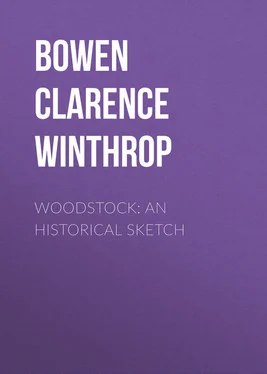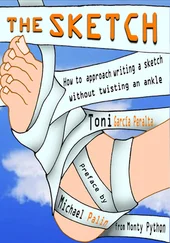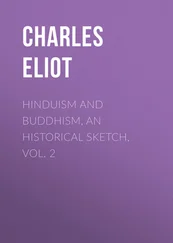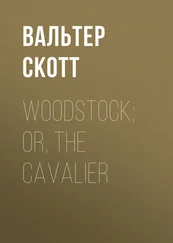Clarence Bowen - Woodstock - An historical sketch
Здесь есть возможность читать онлайн «Clarence Bowen - Woodstock - An historical sketch» — ознакомительный отрывок электронной книги совершенно бесплатно, а после прочтения отрывка купить полную версию. В некоторых случаях можно слушать аудио, скачать через торрент в формате fb2 и присутствует краткое содержание. Жанр: foreign_prose, foreign_antique, Историческая проза, foreign_language, на английском языке. Описание произведения, (предисловие) а так же отзывы посетителей доступны на портале библиотеки ЛибКат.
- Название:Woodstock: An historical sketch
- Автор:
- Жанр:
- Год:неизвестен
- ISBN:нет данных
- Рейтинг книги:3 / 5. Голосов: 1
-
Избранное:Добавить в избранное
- Отзывы:
-
Ваша оценка:
- 60
- 1
- 2
- 3
- 4
- 5
Woodstock: An historical sketch: краткое содержание, описание и аннотация
Предлагаем к чтению аннотацию, описание, краткое содержание или предисловие (зависит от того, что написал сам автор книги «Woodstock: An historical sketch»). Если вы не нашли необходимую информацию о книге — напишите в комментариях, мы постараемся отыскать её.
Woodstock: An historical sketch — читать онлайн ознакомительный отрывок
Ниже представлен текст книги, разбитый по страницам. Система сохранения места последней прочитанной страницы, позволяет с удобством читать онлайн бесплатно книгу «Woodstock: An historical sketch», без необходимости каждый раз заново искать на чём Вы остановились. Поставьте закладку, и сможете в любой момент перейти на страницу, на которой закончили чтение.
Интервал:
Закладка:
“Then I began a Court among the Indians, and first I approved their teacher, Sampson, and their constable, Black James, 20 20 Black James was a distinguished Indian. He met Eliot again in Cambridge in June of 1681, where a meeting of the claimants of the Nipmuck country was held. The village and much of the land of the town of Dudley was known years after the settlement of Woodstock as “The Land of Black James and Company.” – Ammidown’s “Historical Collections,” vol. i., 406, 461.
giving each of them a charge to be diligent and faithful in their places. Also I exhorted the people to yield obedience to the gospel of Christ and to those set in order there. Then published a warrant or order, that I had prepared, empowering the constable to suppress drunkenness, Sabbath breaking, especially powowing and idolatry. And, after warning given, to apprehend all delinquents and bring them before authority to answer for their misdoings; the smaller faults to bring before Watasacompamun, ruler of the Nipmuck country; for idolatry and powowing to bring them before me: So we took leave of this people of Wabquissit, and about eleven o’clock returned back to Maanexit and Chabanakougkomun, where we lodged this night.”
History fails to locate the spot where John Eliot’s sermon to the Indians of Woodstock was delivered, but tradition points to “Pulpit Rock,” so-called, under the aged chestnut trees of the McClellan farm near the “Old Hall” 21 21 Named after “Wabbaquasset Hall,” built in the spring or summer of 1686.
road.
But Eliot’s good work in the Nipmuck country was destroyed when King Philip’s war broke out in 1675. In August of that year a company of Providence men journeyed as far as Wabbaquasset, thinking that possibly King Philip himself had escaped thither. 22 22 Palfrey’s “History of New England,” vol. iii., 159.
They found an Indian fort a mile or two west of Woodstock Hill, but no Indians. A party from Norwich in June of the following year also found deserted Wabbaquasset and the other Praying Villages. Desolation and devastation followed the disappearance of the Red Man. The Nipmuck country became more a wilderness than ever, forsaken of its aboriginal inhabitants whose barbaric tenure could not stand against a superior civilization.
“Forgotten race, farewell! Your haunts we tread,
Our mighty rivers speak your words of yore,
Our mountains wear them on their misty head,
Our sounding cataracts hurl them to the shore;
But on the lake your flashing oar is still,
Hush’d is your hunter’s cry on dale and hill,
Your arrow stays the eagle’s flight no more,
And ye, like troubled shadows, sink to rest
In unremember’d tombs, unpitied and unbless’d.” 23 23 Mrs. L. H. Sigourney’s “Pocahontas.”
IV
The time had now arrived for the white man to make a settlement at Wabbaquasset. In May, of 1681, the General Court of Massachusetts Bay had given to William Stoughton and Joseph Dudley the care of the Nipmuck country, with power to ascertain the titles belonging to the Indians and others, and a meeting of the claimants was held the following month at Cambridge, at which John Eliot rendered much assistance as interpreter. Dudley and Stoughton purchased all the claims, and the following year, 24 24 Feb. 10, 1682.
the whole Nipmuck country became the property of Massachusetts Bay. Jurisdiction over the country had already been claimed, under the terms of the Massachusetts charter. Many of the inhabitants of the town of Roxbury now felt that they could improve their condition and increase their usefulness by forming a settlement in some desirable portion of the new country. Undoubtedly their pastor, John Eliot, had told them of the beauty and fertility of the country about the Praying Villages of Maanexit, Quinnatisset, and Wabbaquasset. 25 25 Ellis’ “History of Roxbury Town”: “When the people of Roxbury came to take up lands, they selected their locations amongst the praying Indians or where Indians had been converted to Christianity… This certainly is a sure indication of the steady adherence of his [John Eliot’s] fellow-townsmen and their belief in the actual benefits of his missionary labors.”
Town meetings to arrange for a new settlement, were held in Roxbury in October of 1683. 26 26 Oct. 6, 10, and 17.
A petition was signed, by a number of representative citizens of the town, asking that the General Court might grant to them a tract seven miles square about Quinnatisset, in the Nipmuck country. All save six of the thirty-six who signed this petition, afterwards became settlers of the new town, and of the five selectmen of Roxbury who presented the petition to the General Court, three 27 27 Joseph Griggs, John Ruggles, and Edward Morris.
represented families prominent in the early history of Woodstock. The General Court at once granted 28 28 Dec. 5, 1683.
the petition provided the grant should not fall within a section to be reserved for Messrs Stoughton and Dudley, and Major Thompson, and provided also that thirty families should be settled on the plantation within three years from the following June, “and mainteyne amongst them an able, orthodox, godly minister.” 29 29 “Records of the Governor and Company of Massachusetts Bay in New England,” vol. v., 426.
In 1684 Roxbury accepted the terms of the General Court, and sent Samuel and John Ruggles, John Curtis, and Edward Morris, as a committee of four, to “view the wilderness and find a convenient place.”
As Quinnatisset had been in part already granted, the committee reported 30 30 Oct. 27, 1684.
a territory “commodiose” for settlement at “Seneksuk and Wapagusset and the lands ajasiant.” A committee was therefore appointed to draw up an agreement for the “goers,” as they were called, to sign. In 1685, 31 31 Jan. 28th.
in answer to the petition of Edward Morris, deputy in behalf of the town of Roxbury, the General Court extended the limit of the time of settlement from June 10, 1687, to Jan. 31, 1688, and granted freedom from rates up to that time. 32 32 “Records of the Governor and Company of the Massachusetts Bay in New England,” vol. v., 468.
At town meetings held in Roxbury, during the same year, it was arranged that one half of the grant should belong to the new settlers and one hundred pounds in money be given to them in instalments of twenty pounds a year, and the other half of the grant should belong to “the stayers” in consideration of the aid given “the goers.” The southern half of the grant was the portion subsequently occupied by “the goers.” Actual possession, however, was not taken until April of the following year. On the second page of the cover of the old and musty first volume of records of the proprietors of New Roxbury, afterwards called Woodstock, are these words:
Конец ознакомительного фрагмента.
Текст предоставлен ООО «ЛитРес».
Прочитайте эту книгу целиком, купив полную легальную версию на ЛитРес.
Безопасно оплатить книгу можно банковской картой Visa, MasterCard, Maestro, со счета мобильного телефона, с платежного терминала, в салоне МТС или Связной, через PayPal, WebMoney, Яндекс.Деньги, QIWI Кошелек, бонусными картами или другим удобным Вам способом.
Читать дальшеИнтервал:
Закладка:
Похожие книги на «Woodstock: An historical sketch»
Представляем Вашему вниманию похожие книги на «Woodstock: An historical sketch» списком для выбора. Мы отобрали схожую по названию и смыслу литературу в надежде предоставить читателям больше вариантов отыскать новые, интересные, ещё непрочитанные произведения.
Обсуждение, отзывы о книге «Woodstock: An historical sketch» и просто собственные мнения читателей. Оставьте ваши комментарии, напишите, что Вы думаете о произведении, его смысле или главных героях. Укажите что конкретно понравилось, а что нет, и почему Вы так считаете.












